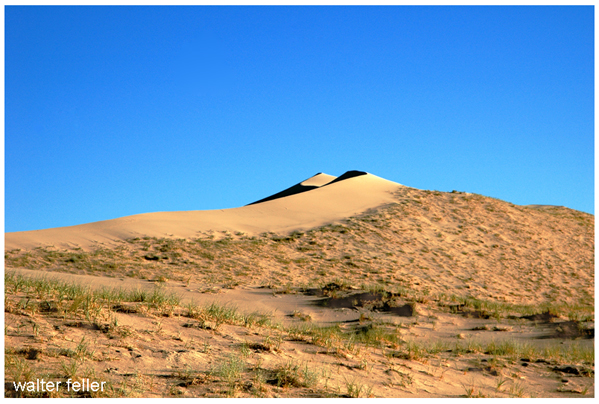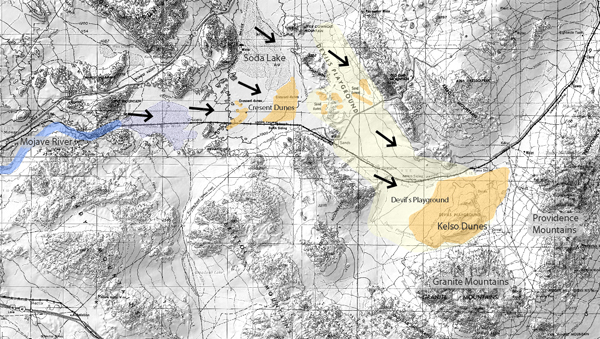--
Kelso Dunes

The Kelso Dunes are notable for the phenomenon known as singing sand, or "booming dunes". Hikers typically climb to the top of the dunes and slide down slowly, generating a low-frequency rumble that can be both felt and heard. This effect has also been noted at the Eureka Dunes in Death Valley National Park.
The Kelso Dune complex has some of the highest dunes (600 feet,160 meters) in the region. Few people realize however, that these magnificent dunes form only a small part of a much larger sand transport system that includes the Devil's Playground.
This extraordinary dune system has an unexpectedly mysterious history. Huge amounts of sand were needed to build Kelso's delicate wind-created sculptures, but geologists studying the Preserve discovered that no new sand is moving in to replenish the dunes. Where did the sand originally come from? What made it stop accumulating? The Kelso Dune sands remained a mystery until very recently.
By studying the mineral composition and shapes of sand grains that make up Kelso Dunes, we know that most of the sand has traveled all the way from the Mojave River sink east of Afton Canyon. Wind blowing from the northwest gradually carried the sand southeastward. In the path of the prevailing winds lie the Providence Mountains and the pink pinnacles of the Granite Mountains. The rocky crags and sloping fans of the two ranges block the moving sand. Sand piles up at the base of the mountains and along their flanks, forming dunes and sand sheets.

click for larger map
Where the sand piles up researchers found that the dunes are actually made up of several sets of dunes, stacked one on top of another. Each set formed in response to some past climate change! The Kelso Dunes depend upon times when the sand grain (sediment) supply is enhanced. This happens whenever the climate is dry enough to expose the raw material of dunes, sand, to the wind. In fact, most of the eastern part of the Kelso Dunes formed when water-filled Soda Lake and Silver Lake dried up, exposing the lake bottom sediment. The entire dune system was stacked up in five major pulses over the past 25,000 years.
Sand is made up of minerals and tiny pieces rock that were once part of another, much larger rock. Over time, the slow processes of weathering and erosion can turn large rocks into sand. Geologists can often track down the original source for sand grains by comparing the minerals and other characteristics of the sand with rocks in mountains nearby.
Most of the sand grains you'll see at Kelso Dunes are made of the light colored minerals quartz and feldspar. These grains were probably eroded from granitic rocks in the San Bernardino Mountains and transported eastward by the Mojave River.
As you explore the dunes take a close look at the crests. Very fine sand grains of black, iron-rich magnetite tend to accumulate on the surface. Amphibole is another black mineral you can find here. It's easy to pick out the magnetite from the amphibole by dragging a magnet across the sand. As the name implies, magnetite is magnetic.
Also see:
Sand Dunes in the Mojave
Sand dunes form wherever environmental conditions provide sand, steady wind and a ...Sand Dune Formation
Processes involving sand and dust transport play an important roll in shaping the ...The Desert Sand Dunes Habitat
Perhaps you will see a Mojave fringe-toed lizard skitter across the dunes. Look also for tracks, especially of ...Mojave fringe-toed lizard
Fringe-toed lizards are primarily insectivorous and their diet includes ants, beetles, grasshoppers, sand-dwelling cockroaches, hemipterans, spiders, antlion larvae, and ...Kit fox
Kit foxes primarily are carnivorous. The principal foods are black-tailed jackrabbits and desert cottontails, rodents (especially ...


